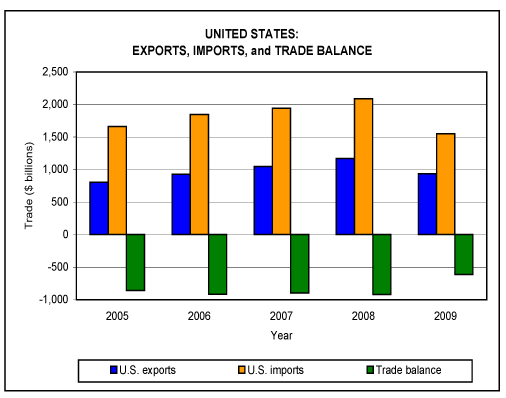About this Report
Publication No. 4179
Investigation No. 332-345
Date: August 2010
View Section in Publication
Click here to order CD-ROM
This site provides analysis, data, and information resources showing competitive aspects of U.S. merchandise trade trends on a country and sector basis.
Exports, Imports and Trade Balance
Key Economic Events
- In 2009, the U.S. merchandise trade deficit fell by $308.2 billion (33 percent) to $612.4 billion. U.S. imports and exports fell by 26 percent and 20 percent, respectively, in 2009, reflecting the downturn in the U.S. and world economies that resulted in reduced demand for imports and U.S. exports. In 2009, most U.S. merchandise trade deficits with major trading partners also fell.
- The decline in U.S. imports reflected reduced U.S. real GDP, which fell by 2.4 percent in 2009. Consumer spending in the United States fell by 0.6 percent in 2009, and gross private domestic investment fell by 23.2 percent. Major U.S. export partners, such as Canada, the European Union, Mexico, and Japan, also experienced declines in real GDP, thereby reducing their demand for U.S. exports. China's real GDP, in contrast, rose by 9 percent.
- The U.S. merchandise trade deficit was affected substantially by the lower price of crude petroleum, which resulted in a 45 percent decline in the import value of energy-related products. In contrast, U.S. imports of non-energy-related merchandise fell by 20.3 percent. U.S. imports of energy-related products declined as a share of total merchandise imports on a value basis, from 23 percent in 2008 to 17 percent in 2009.
- The sector with the largest trade deficit ($201.1 billion) and the largest absolute deficit decline was energy-related products, primarily as a result of falling prices. Declining demand in end-markets such as construction and durable goods manufacturing caused the minerals and metals sector trade deficit to decrease by $32.6 billion (50 percent).
- The greatest absolute decrease in U.S. exports was in the transportation equipment sector, where exports fell by $63.4 billion (25 percent) to $194.1 billion in 2009. The largest decline in U.S. imports was of energy-related products, which fell by $211.4 billion in 2009.
- Changes in the value of the dollar in 2009 likely contributed to the downturn in U.S. exports in early 2009, but helped to improve the competitiveness of U.S.-made goods in the latter part of the year. The average trade-weighted value of the dollar measured against an index of major foreign currencies rose by 5 percent in 2009 as compared to 2008, but it peaked in the first quarter of 2009 and then fell steadily throughout the remainder of the year.
- China, the European Union (EU), Canada, and Mexico, the four largest U.S. trading partners, together accounted for more than 70 percent of the U.S. trade deficit in the period 2008 to 2009. The merchandise deficits with each of these countries declined in 2009.
Trade Shifts from 2008 to 2009
- U.S. trade deficit: Decreased by $308.2 billion (34 percent) to $612.4 billion
- U.S. exports: Decreased by $233.1 billion (20 percent) to $936.7 billion
- U.S. imports: Decreased by $541.3 billion (26 percent) to $1.5 trillion
Sector Shifts
This part of the report examines shifts in trade for ten merchandise sectors: agriculture; chemicals and related products; electronic products; energy-related products; forest products; machinery; minerals and metals; miscellaneous manfactures; textiles, apparel, and footwear; and transportation equipment. The following links download as PDF files.
Agricultural Products :: Chemicals and Related Products :: Electronic Products :: Energy and Related Products :: Forest Products :: Machinery :: Minerals and Metals :: Miscellaneous Manufactures :: Textiles, Apparel, and Footwear :: Transportation Equipment
Country Shifts
This part of the report analyzes shifts in trade between the United States and nine significant trading partners. The following links download as PDF files.
Brazil :: Canada :: China :: European Union :: India :: Japan :: Mexico :: Republic of Korea :: Russia
|
General Contact Brendan Lynch Michelle Koscielski |
Media Contact Peg O'Laughlin |

